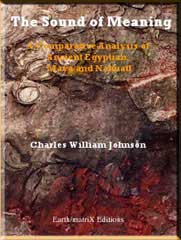
Extract Nº. 43
Linguistic Correspondence:
Nahuatl and Ancient Egyptian
Charles William Johnson
In our more detailed analyses of the possible correspondence among words of the ancient Egyptian language and nahuatland maya, we have seen that some word-concepts are almost exactly the same in phonetic values. Furthermore, the maya glyphs and ancient Egyptian hieroglyphs share extremely common designs in similar/same word-concepts.
Today, the idea of linguistic correspondence among the Indo-European languages is a widespread fact. From the still unknown Indo-European mother language it is thought came Sanskrit (and the contemporary languages of Pakistan and India); Persian; and Greek, Latin (and many contemporary European languages). The correspondence of similar/same words among the Latin languages is quite visible, with Spanish words, for example, resembling those of French, Italian and Portuguese. English resembles the Teutonic ones, such as, German, Dutch and the Scandinavian languages.
On the other hand, no apparent linguistic correspondence has been observed between ancient Egyptian and languages such as nahuatl or maya, at least to any significant scholarly degree. In the aforementioned essay, we have examined numerous correspondences between word-concepts (and some glyphs) between the ancient Egyptian language and the maya system. The word for day name in maya is ahau, which means place or time in ancient Egyptian. Hom is ballcourt in maya; hem means little ball in ancient Egyptian. Ik means air in maya ; to suspend in the air is ikh in ancient Egyptian. Nichim signifies flower in maya; nehem means bud, flower in ancient Egyptian. And so on, for hundreds of word-concepts that we have examined in the comparison of these two languages.
When similar kinds of linguistic correspondences were perceived by William Jones, in the latter part of the eighteenth century, between Sanskrit and other languages, such examples were sufficient to convince scholars that all of those languages probably came from a mother tongue, the Indo-European language. Today, when linguistic correspondence is observed between the ancient Mesoamerican languages and ancient Egyptian, scholars are unwilling or hesitant to accept the idea that the same laws of linguistics may apply. The reason for this is quite simple: there is no historical basis for considering the possibility that the peoples of these different languages had any physical contact among themselves. Physical contact among the peoples who descended from the Indo-European family is established by historical data. There is no obvious historical data to think that the peoples of ancient Mesoamerica and the peoples of ancient Egypt ever met or came into physical contact with one another.
Nevertheless, historical data aside for the moment, let us examine some of the obvious examples of linguistic correspondence between nahuatl and the ancient Egyptian language.
One very obvious characteristic of the nahuatl language is the extensive use of the letter "l" in most of the words, either as ending to the words or juxtaposed to consonants and vowels within the words. One of the very apparent characteristics of the ancient Egyptian language is the almost total absence of the use of the letter "l" within most of its word-concepts. The letter "l" appears as an ending of words only a handful of times in E.A. Wallis Budge's work, An Egyptian Hieroglyphic Dictionary. It would appear that this very dissimilar characteristic between these two languages would discourage anyone from considering a comparative analysis of possible linguistic correspondence between these two very apparently distinct idioms.
However, as we eliminate the letter "l" from the nahuatl words, the remaining phonemes (listed in brackets) resemble the phonemes and morphemes of ancient Egyptian in many cases. Let us offer only a few of such examples to consider a possible linguistic correspondence between these two fascinating systems of human speech.
| Nahuatl |
| Egyptian |
| canoe | ACAL [aca-] |
| AQAI | boat (page 139b from Budge's work cited above) | |
| reed | ACATL[acat-] |
| AQ |
| AKHAH-T | reed (139b) |
| reed (8a) | ||
| a well | AMELLI [ame-i] |
| AMAM | place with water in them, wells (121b) | |
| house | CALLI [ca-i] |
| KA | house (783a) | |
| serpent ... | COATL [coat-] .... ... |
| KHUT ... ... | snake (30b) .... ... |
Read more: johnson@earthmatrix.com
Sounds, Symbols and Meaning explores coincidences in the word-concepts and glyphs of these ancient languages. Two distinct cultures, the ancient Egyptians and the cultures of Mesoamerica appear to have had very similar speaking traits. They both saw a deer, and coincidentally each one thought the sound "ma"; they saw water and both used the sound "at"; they looked at the sky and both again mumbled an initial "k" sound; they saw the dew on flowers and said to themselves a sound beginning with "it"; they looked at their feet and voiced the sound "b"; they got drunk and sounded a "tek" word; they looked at the mountain and said a word beginning with the letter "t"; they saw a lion and said an "m" word; then, they saw the moon and mumbled another "m" word; and so on. Hundreds of similarly related word-concepts and symbols are explored in this brief study in comparative philology, which reveals the possibility that these ancient cultures may have had contact with one another. To attribute so many similarities of sound, symbol and meaning to mere coincidence contradicts the laws of probability.
Sounds, Symbols and Meaning:
Ancient Egyptian, Maya and Nahuatl
Charles William Johnson

Ancient Egyptian, Maya and Nahuatl
Charles William Johnson

No comments:
Post a Comment